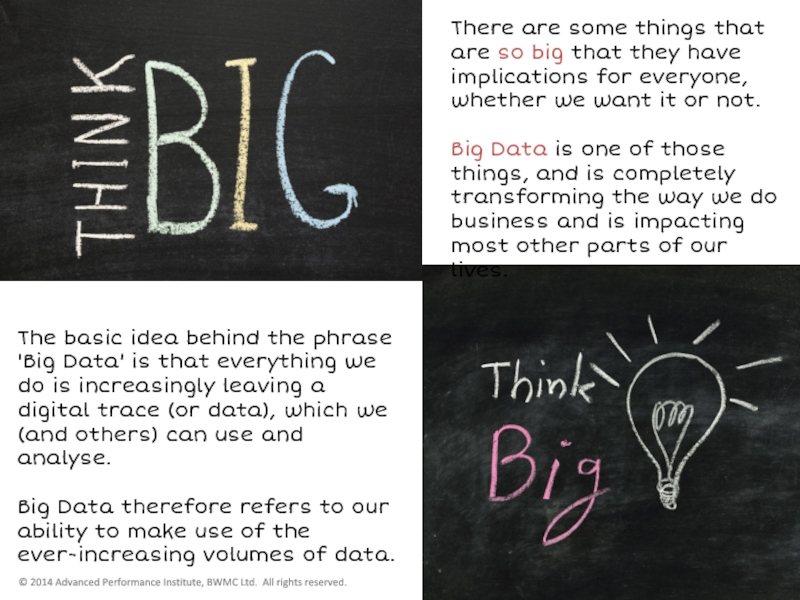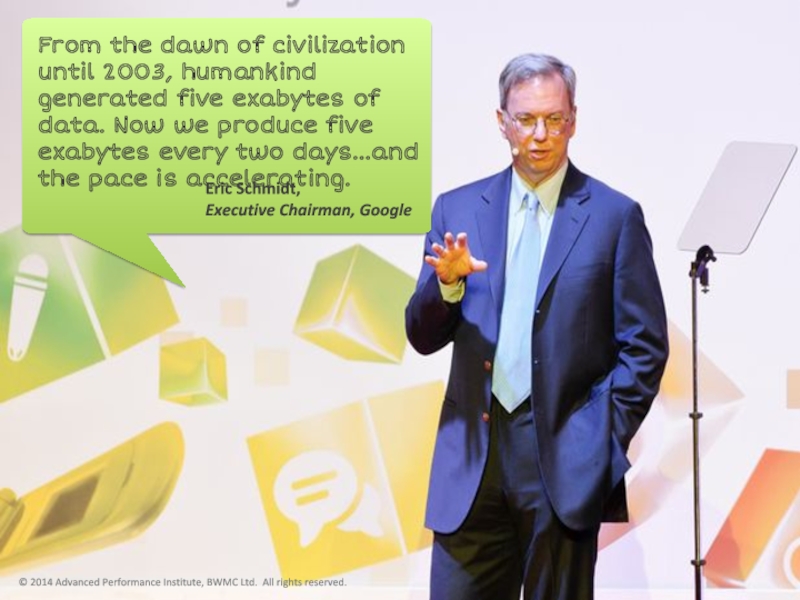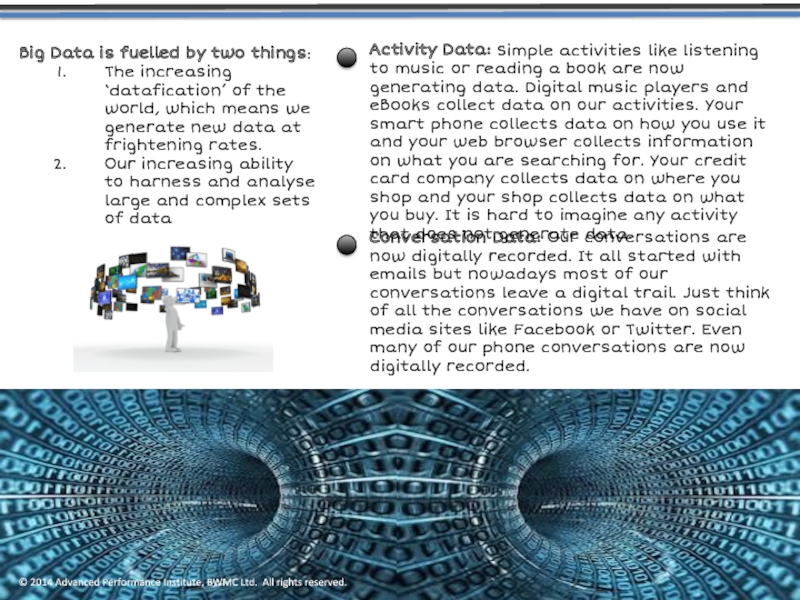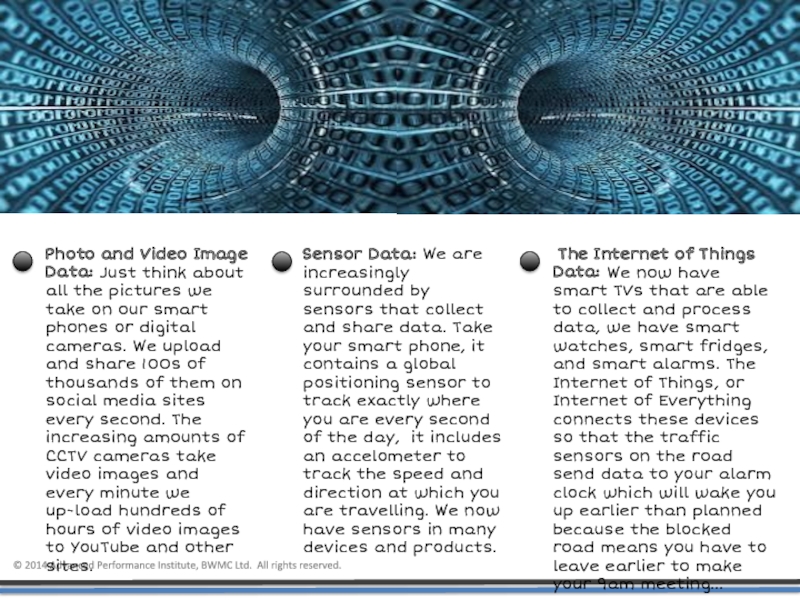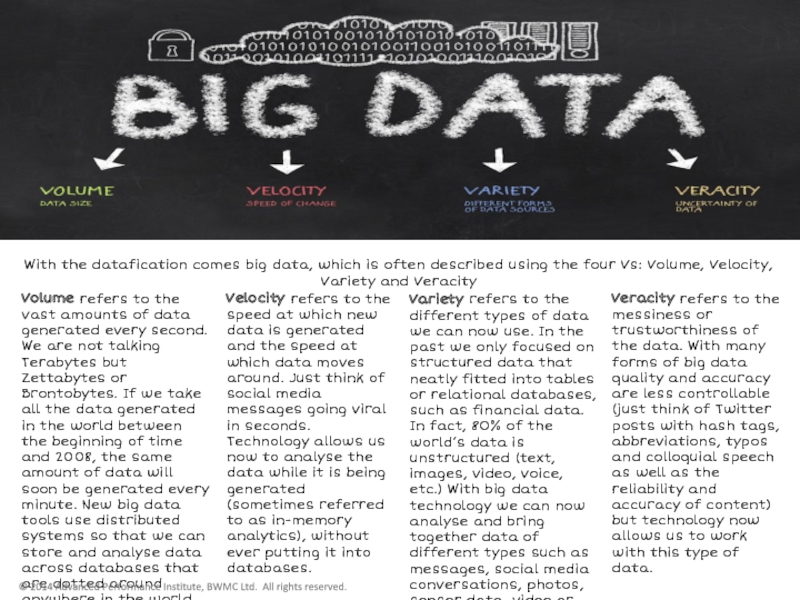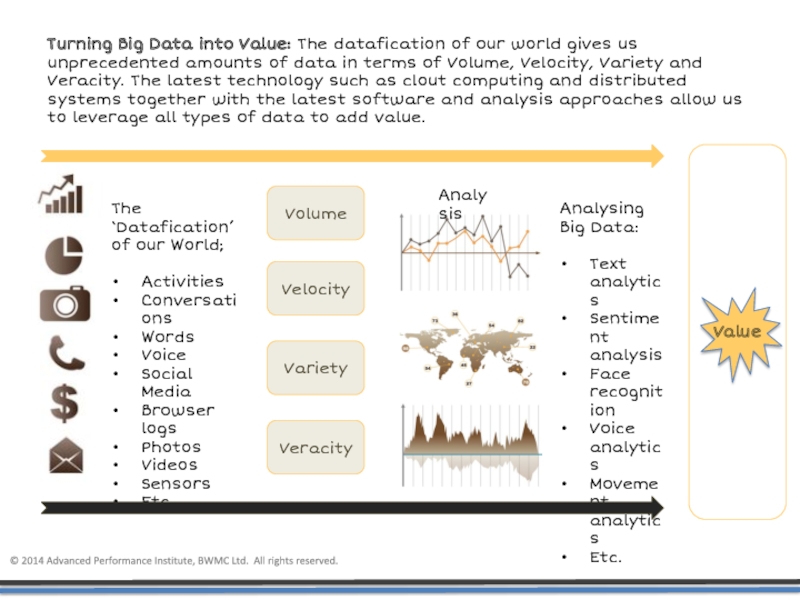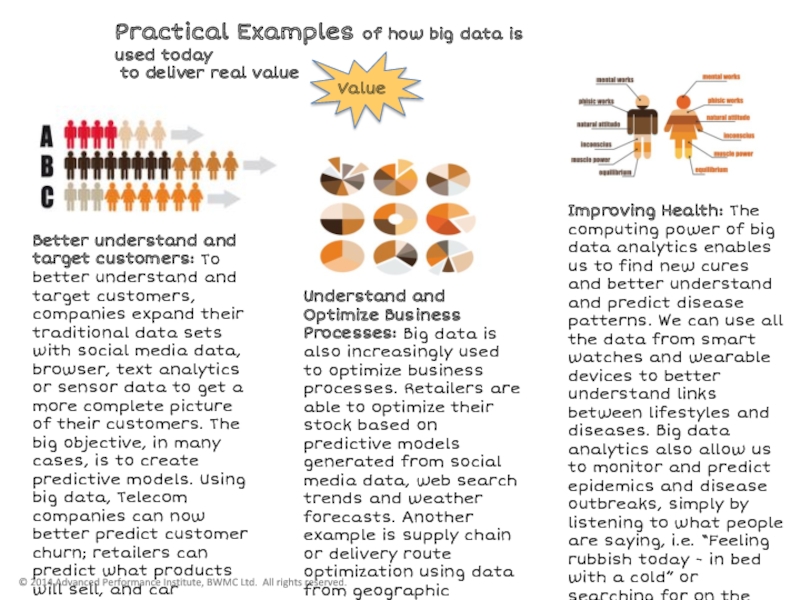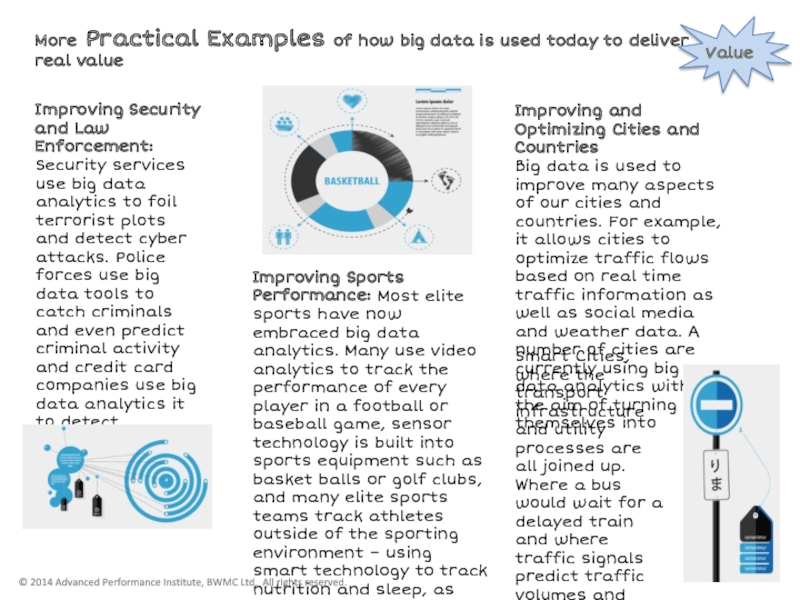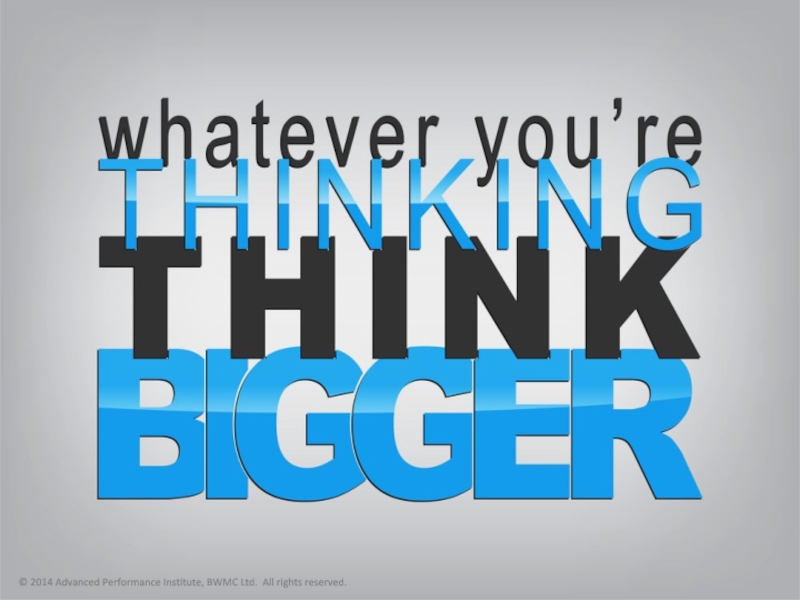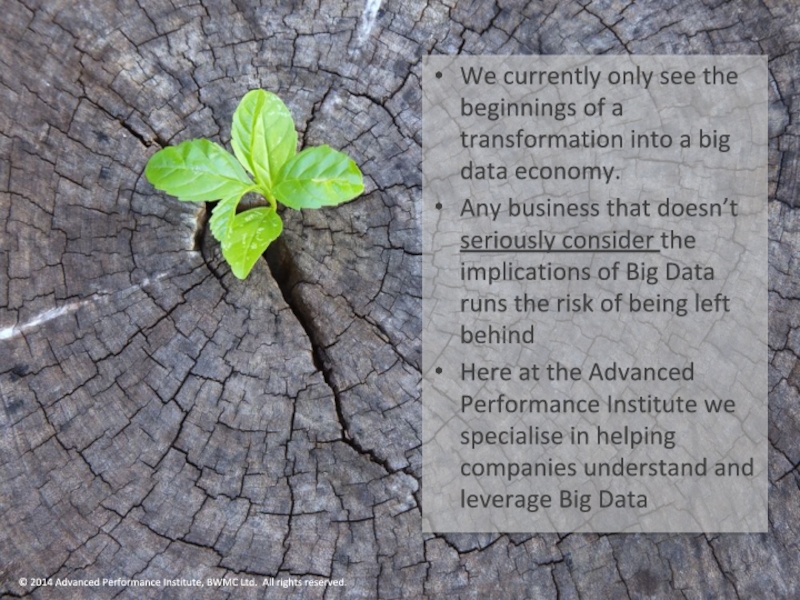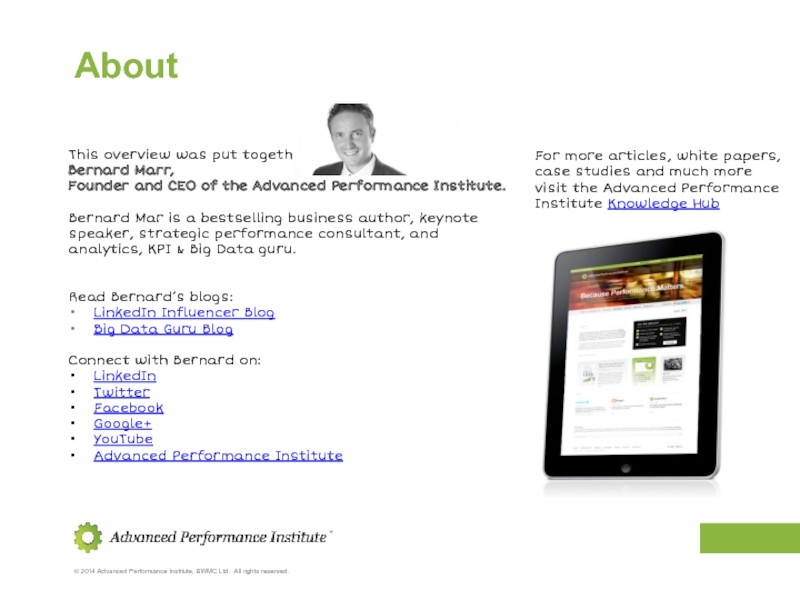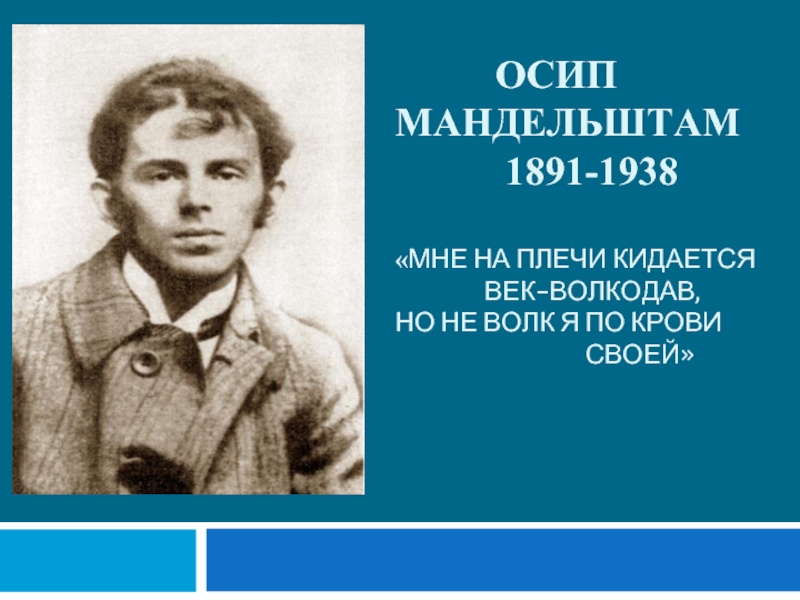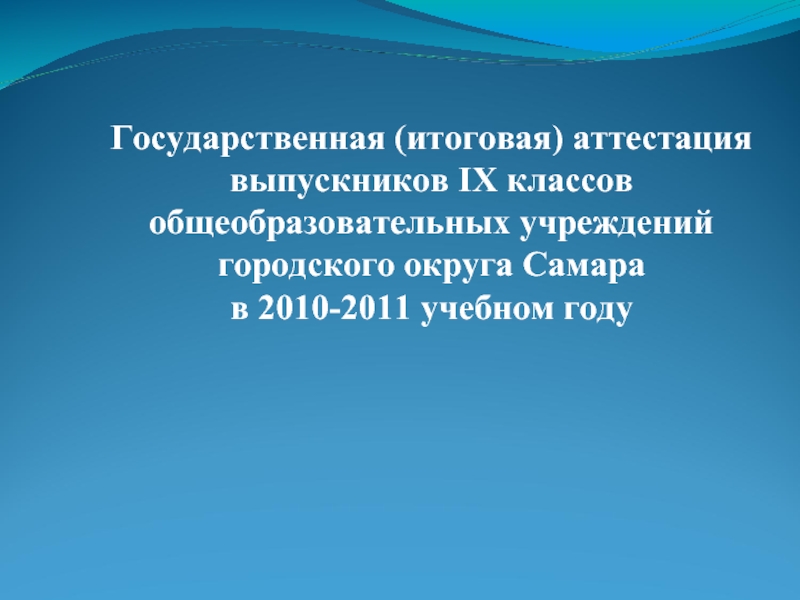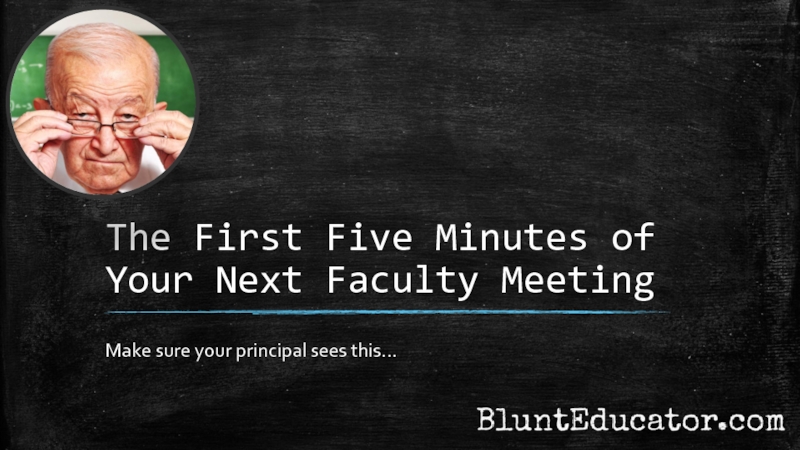- Главная
- Разное
- Дизайн
- Бизнес и предпринимательство
- Аналитика
- Образование
- Развлечения
- Красота и здоровье
- Финансы
- Государство
- Путешествия
- Спорт
- Недвижимость
- Армия
- Графика
- Культурология
- Еда и кулинария
- Лингвистика
- Английский язык
- Астрономия
- Алгебра
- Биология
- География
- Детские презентации
- Информатика
- История
- Литература
- Маркетинг
- Математика
- Медицина
- Менеджмент
- Музыка
- МХК
- Немецкий язык
- ОБЖ
- Обществознание
- Окружающий мир
- Педагогика
- Русский язык
- Технология
- Физика
- Философия
- Химия
- Шаблоны, картинки для презентаций
- Экология
- Экономика
- Юриспруденция
What is Big Data by Bernard Marr, Advanced Performance Institute презентация
Содержание
- 1. What is Big Data by Bernard Marr, Advanced Performance Institute
- 2. There are some things that are so
- 3. © 2014 Advanced Performance Institute, BWMC Ltd. All rights reserved.
- 4. © 2014 Advanced Performance
- 5. © 2014 Advanced
- 6. With the datafication comes big data, which
- 7. Turning Big Data into Value: The
- 8. Practical Examples of how big data is
- 9. More Practical Examples of how big data
- 10. © 2014 Advanced Performance Institute, BWMC Ltd. All rights reserved.
- 11. We currently only see the beginnings of
- 12. About This overview was put together by
Слайд 1What is Big Data by Bernard Marr, Advanced Performance Institute
© 2014
Слайд 2There are some things that are so big that they have
Big Data is one of those things, and is completely transforming the way we do business and is impacting most other parts of our lives.
The basic idea behind the phrase 'Big Data' is that everything we do is increasingly leaving a digital trace (or data), which we (and others) can use and analyse.
Big Data therefore refers to our ability to make use of the ever-increasing volumes of data.
© 2014 Advanced Performance Institute, BWMC Ltd. All rights reserved.
Слайд 4
© 2014 Advanced Performance Institute, BWMC Ltd. All rights reserved.
Activity Data:
Conversation Data: Our conversations are now digitally recorded. It all started with emails but nowadays most of our conversations leave a digital trail. Just think of all the conversations we have on social media sites like Facebook or Twitter. Even many of our phone conversations are now digitally recorded.
Big Data is fuelled by two things:
The increasing ‘datafication’ of the world, which means we generate new data at frightening rates.
Our increasing ability to harness and analyse large and complex sets of data
Слайд 5
© 2014 Advanced Performance Institute, BWMC Ltd. All rights reserved.
Photo and
Sensor Data: We are increasingly surrounded by sensors that collect and share data. Take your smart phone, it contains a global positioning sensor to track exactly where you are every second of the day, it includes an accelometer to track the speed and direction at which you are travelling. We now have sensors in many devices and products.
The Internet of Things Data: We now have smart TVs that are able to collect and process data, we have smart watches, smart fridges, and smart alarms. The Internet of Things, or Internet of Everything connects these devices so that the traffic sensors on the road send data to your alarm clock which will wake you up earlier than planned because the blocked road means you have to leave earlier to make your 9am meeting…
Слайд 6With the datafication comes big data, which is often described using
Volume refers to the vast amounts of data generated every second. We are not talking Terabytes but Zettabytes or Brontobytes. If we take all the data generated in the world between the beginning of time and 2008, the same amount of data will soon be generated every minute. New big data tools use distributed systems so that we can store and analyse data across databases that are dotted around anywhere in the world.
Velocity refers to the speed at which new data is generated and the speed at which data moves around. Just think of social media messages going viral in seconds. Technology allows us now to analyse the data while it is being generated (sometimes referred to as in-memory analytics), without ever putting it into databases.
Variety refers to the different types of data we can now use. In the past we only focused on structured data that neatly fitted into tables or relational databases, such as financial data. In fact, 80% of the world’s data is unstructured (text, images, video, voice, etc.) With big data technology we can now analyse and bring together data of different types such as messages, social media conversations, photos, sensor data, video or voice recordings.
Veracity refers to the messiness or trustworthiness of the data. With many forms of big data quality and accuracy are less controllable (just think of Twitter posts with hash tags, abbreviations, typos and colloquial speech as well as the reliability and accuracy of content) but technology now allows us to work with this type of data.
© 2014 Advanced Performance Institute, BWMC Ltd. All rights reserved.
Слайд 7
Turning Big Data into Value: The datafication of our world gives
The ‘Datafication’ of our World;
Activities
Conversations
Words
Voice
Social Media
Browser logs
Photos
Videos
Sensors
Etc.
Volume
Veracity
Variety
Velocity
Analysis
Analysing
Big Data:
Text analytics
Sentiment analysis
Face recognition
Voice analytics
Movement analytics
Etc.
Value
© 2014 Advanced Performance Institute, BWMC Ltd. All rights reserved.
Слайд 8Practical Examples of how big data is used today
to deliver
Value
Better understand and target customers: To better understand and target customers, companies expand their traditional data sets with social media data, browser, text analytics or sensor data to get a more complete picture of their customers. The big objective, in many cases, is to create predictive models. Using big data, Telecom companies can now better predict customer churn; retailers can predict what products will sell, and car insurance companies understand how well their customers actually drive.
Understand and Optimize Business Processes: Big data is also increasingly used to optimize business processes. Retailers are able to optimize their stock based on predictive models generated from social media data, web search trends and weather forecasts. Another example is supply chain or delivery route optimization using data from geographic positioning and radio frequency identification sensors.
Improving Health: The computing power of big data analytics enables us to find new cures and better understand and predict disease patterns. We can use all the data from smart watches and wearable devices to better understand links between lifestyles and diseases. Big data analytics also allow us to monitor and predict epidemics and disease outbreaks, simply by listening to what people are saying, i.e. “Feeling rubbish today - in bed with a cold” or searching for on the Internet.
© 2014 Advanced Performance Institute, BWMC Ltd. All rights reserved.
Слайд 9More Practical Examples of how big data is used today to
Value
Improving Security and Law Enforcement: Security services use big data analytics to foil terrorist plots and detect cyber attacks. Police forces use big data tools to catch criminals and even predict criminal activity and credit card companies use big data analytics it to detect fraudulent transactions.
Improving Sports Performance: Most elite sports have now embraced big data analytics. Many use video analytics to track the performance of every player in a football or baseball game, sensor technology is built into sports equipment such as basket balls or golf clubs, and many elite sports teams track athletes outside of the sporting environment – using smart technology to track nutrition and sleep, as well as social media conversations to monitor emotional wellbeing.
Improving and Optimizing Cities and Countries
Big data is used to improve many aspects of our cities and countries. For example, it allows cities to optimize traffic flows based on real time traffic information as well as social media and weather data. A number of cities are currently using big data analytics with the aim of turning themselves into
Smart Cities, where the transport infrastructure and utility processes are all joined up. Where a bus would wait for a delayed train and where traffic signals predict traffic volumes and operate to minimize jams.
© 2014 Advanced Performance Institute, BWMC Ltd. All rights reserved.
Слайд 11We currently only see the beginnings of a transformation into a
Any business that doesn’t seriously consider the implications of Big Data runs the risk of being left behind
Here at the Advanced Performance Institute we specialise in helping companies understand and leverage Big Data
© 2014 Advanced Performance Institute, BWMC Ltd. All rights reserved.
Слайд 12About
This overview was put together by
Bernard Marr,
Founder and CEO
Bernard Mar is a bestselling business author, keynote speaker, strategic performance consultant, and analytics, KPI & Big Data guru.
Read Bernard’s blogs:
LinkedIn Influencer Blog
Big Data Guru Blog
Connect with Bernard on:
Google+
YouTube
Advanced Performance Institute
For more articles, white papers, case studies and much more visit the Advanced Performance Institute Knowledge Hub

